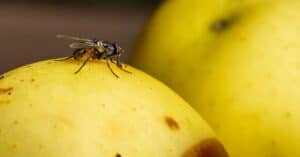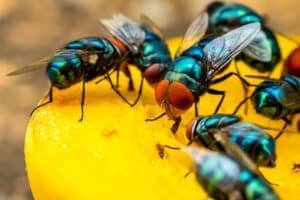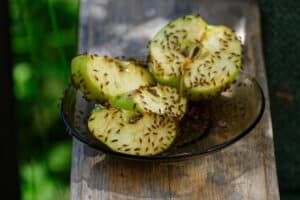If you’ve ever spent time by the water during a hot, muggy summer day, you’ve probably felt the painful bite of a pesky fly or two. Nothing seems to deter them as they wait for unsuspecting swimmers to breach the surface before attacking. And even as you relentlessly swat at them, they keep returning for more.
Their scissor-like mouthparts can be painful and cause redness, itching, and swelling. If you have ever experienced a bite, you may be wondering whether it was a deer fly or a horse fly that bit you. Discover the difference between these two flies, including their appearance, diet, habitat, and behavior.
Deer Fly Vs. Horse Fly: a Comparison
| Deer Fly | Horse fly | |
|---|---|---|
| Size | 0.25 to 0.40 inches long | ¾ to 1 ¼ inches long |
| Appearance | Gray or light brown with dark bands going across clear wings | Black, gray, or brown, with blue, green, or yellow patterning. Clear wings with no bands. |
| Diet | Males consume nectar and pollen; females are blood drinkers | Males consume nectar and pollen; females are blood drinkers |
| Behavior | Aggressive and persistent | Aggressive and persistent |
| Location and Habitat | Worldwide distribution in moist woodlands and wetlands | Worldwide distribution in freshwater and saltwater wetlands. Or any moist soil near water. |
Deer Fly Overview
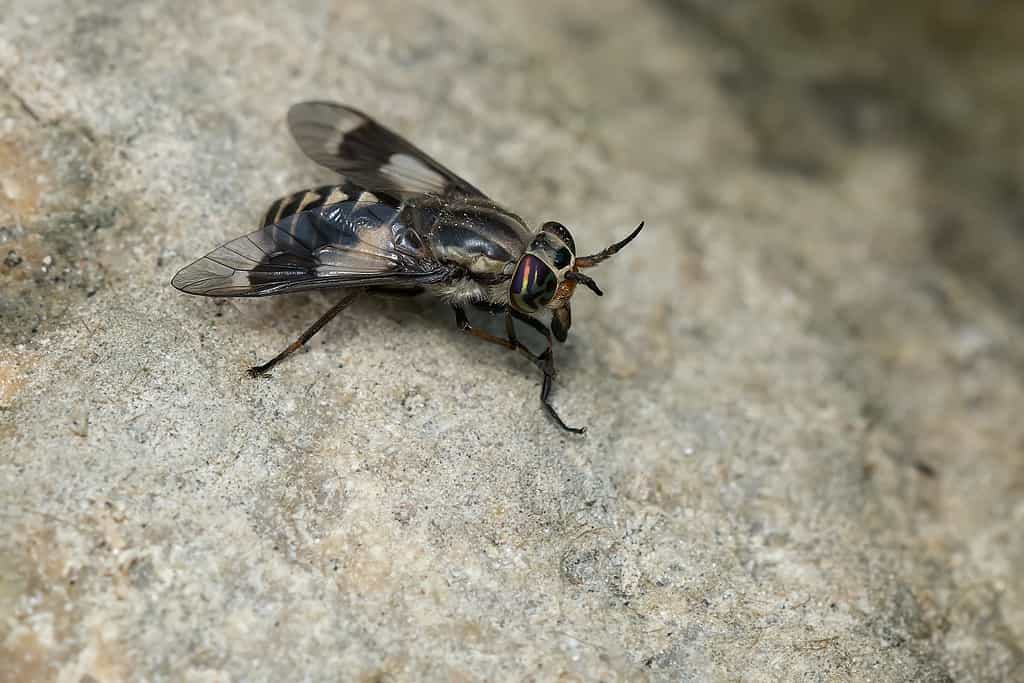
Deer flies have black bands across clear wings.
©Paul Reeves Photography/Shutterstock.com
The term “deer fly” is actually a subfamily (Chrysopsinae) in the Tabanidae family, which includes both deer flies and horse flies. Deer flies are considered “true flies” and pests to humans and cattle.
Appearance
Deer flies are bigger than house flies, measuring 0.25 to 0.40 inches long. But they are smaller than horseflies. They have colored compound eyes and large clear wings. Their wings also have dark bands going across. These flies are most commonly gray or light brown and can also feature black or yellow stripes.
Diet and Behavior
Deer flies, during the larvae stage, feed on organic matter and tiny insects near the water. As adults, males sustain themselves on pollen and flower nectar. Only females are blood feeders. They must drink blood, preferably from mammals, to produce eggs.
It doesn’t take much to attract female deer flies. They are drawn to carbon dioxide, body heat, dark colors, movement, and lights in the dark. And they are most active when the sun is shining directly, and the temperature is above 71℉.
Deer flies are aggressive and will often keep coming back even after shooing them away. They are persistent and will keep trying to bite after being interrupted. And their bites are painful as they have a cross-shaped incision, similar to scissors. After making their incision, they lap up the blood. Their saliva also contains an anti-coagulant, which can cause severe reactions in some people. These flies can also transmit parasites and diseases.
Location and Habitat
The deer fly has a global distribution, except for extreme northern areas like Greenland and Iceland. They inhabit moist woods and wetlands, such as marshes and areas near ponds and streams.
Horse Fly Overview
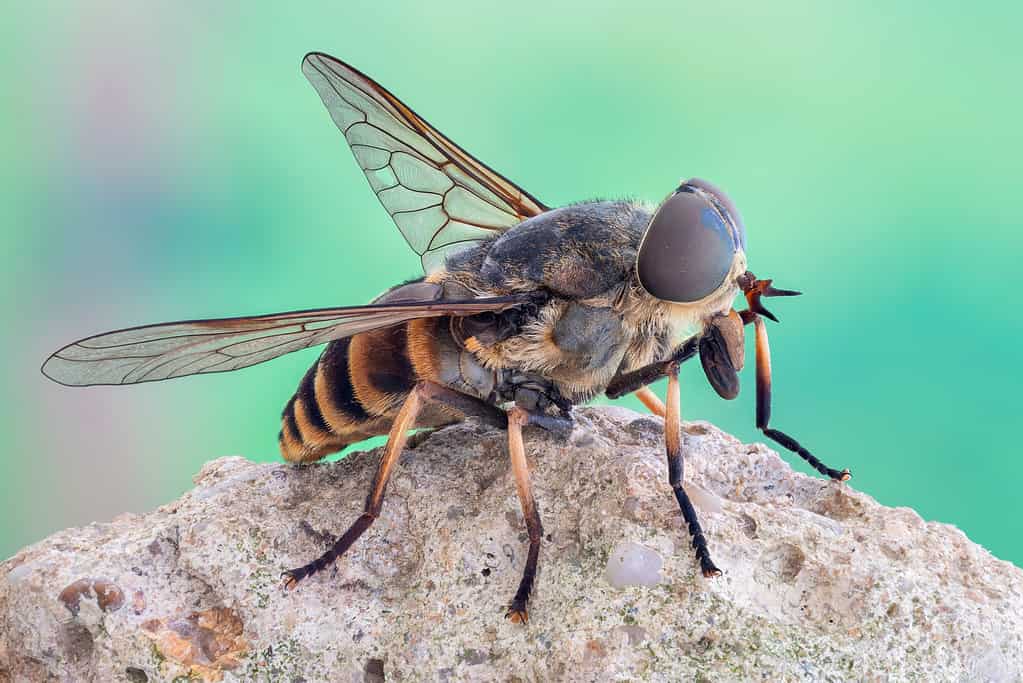
Horseflies are larger than deer flies.
©iStock.com/guraydere
Horseflies are a subfamily belonging to the Tabanidae family, comprising more than 3000 species. Like deer flies, horseflies are true flies and are considered pests. Other names for them, include gadflies, green flies, and green-headed flies.
Appearance
These large flies have compound eyes with bright colors and short antennae. They range in size from ¾ to 1 ¼ inches long. And while they have clear wings, they lack dark bands. Most species of horsefly are black, gray, or brown, and some feature blue, green, or yellow patterning.
Diet and Behavior
Like deer flies, horseflies have the same diet. Males feed on nectar and pollen, while females drink mammal blood to help them produce eggs.
Both flies have the same mouth parts, producing a painful scissor-like bite when they feed. And horseflies are also aggressive towards humans and animals. They are drawn to movement, warmth, sweat, carbon dioxide, and shiny objects. And they will keep coming to finish their meal even after being swatted. Most people only experience mild swelling and itching after being bitten by a horsefly, but others may develop a serious allergic reaction. While they are not major vectors for disease, these flies have been known to transmit certain diseases like tularemia.
Location and Habitat
Horseflies have a worldwide range, except for polar regions and some islands. They like warm, wet areas, preferably moist soil near a body of water. You can find them in freshwater and saltwater, such as marshes and streams.
Deer Fly vs. Horse Fly: Key Differences

The primary difference between the horsefly and the deerfly is their appearance. They differ in the following ways:
- Horseflies are bigger than deer flies.
- The deer fly has black bands on their wings.
- Deer flies are gray or light brown, while horseflies are black, gray, or brown, with blue, green, or yellow patterning.
How Are Flies Beneficial to the Ecosystem?
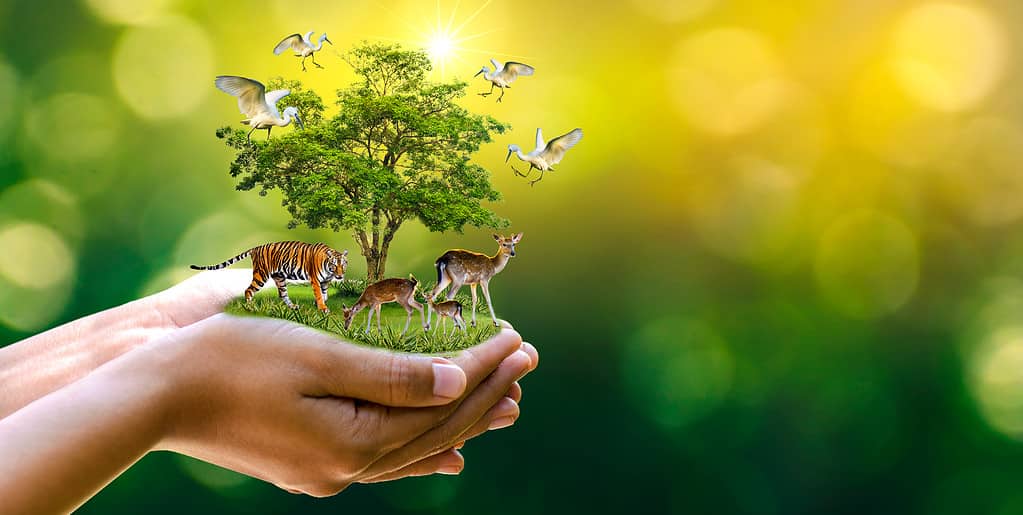
Even though they are pesky, flies play an important role in the ecosystem of our planet.
©sarayut_sy/Shutterstock.com
Deerflies and horseflies are an important part of a healthy ecosystem. These flies are beneficial in a variety of ways, including providing food for other animals, helping with pollination, and breaking down organic material.
One way deerflies and horseflies are beneficial is that they are an important food source for other creatures. Fish, amphibians, birds, and other small mammals rely on these flies as an important source of nutrition. The larvae of these flies are particularly important, as they provide a high-protein meal for many animals.
Another benefit of flies is their role in pollination. Many flies play an important role in the pollination of plants, especially those that don’t attract bees or other pollinators. By visiting flowers and transferring pollen from plant to plant, these flies help to ensure the health and reproduction of many plant species. Some flies also eat aphids, grubs, and caterpillars, which gardeners appreciate.
Finally, these flies also help to break down organic material. Deerflies and horseflies feed on decaying plant and animal matter, which helps to break down the material more quickly. This process is important for releasing nutrients back into the soil and creating fertile ground for future plants.
The photo featured at the top of this post is ©
Thank you for reading! Have some feedback for us? Contact the AZ Animals editorial team.



